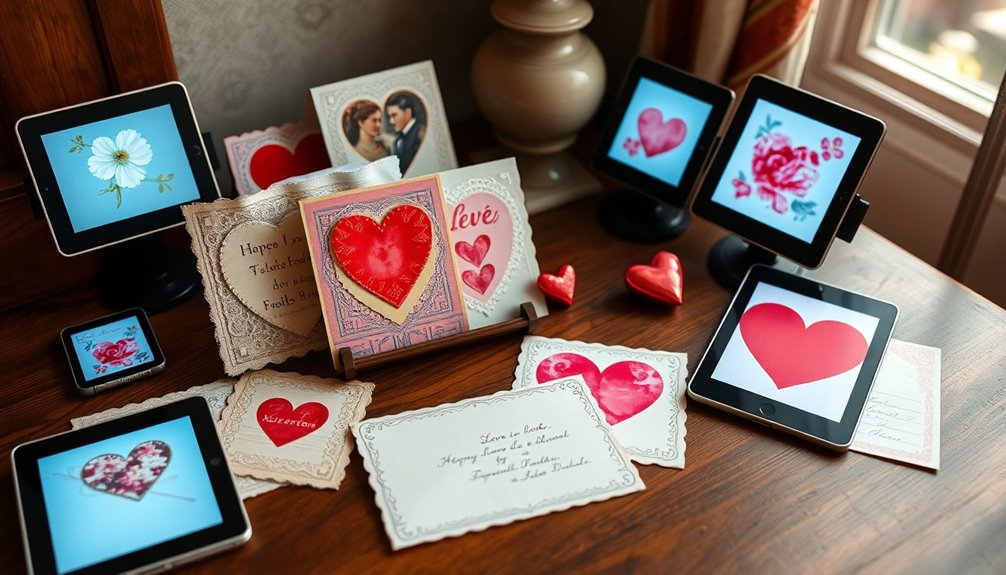Valentine's cards have come a long way, starting as heartfelt handwritten notes in the 15th century, like the one from Charles, Duke of Orleans, to his wife. With the Industrial Revolution, mass production made cards widely accessible, introducing intricate Victorian designs. Today, you can send everything from traditional paper cards to vibrant digital greetings. This transformation reflects our evolving ways of expressing love. There's plenty more to uncover about this fascinating journey through time.
Key Takeaways
- The oldest surviving Valentine's card, written by Charles, Duke of Orleans in 1415, marks the beginning of the tradition of sending love messages.
- The 19th Century saw the mass production of Valentine's cards, making them widely accessible due to advancements in printing technology.
- Victorian Era cards featured intricate designs with lace and ribbons, reflecting the romantic sentiments of the time.
- Today's Valentine's cards include traditional paper, humorous digital versions, and handmade creations, adapting to modern communication trends.
- The rise of e-cards and social media messages illustrates a shift toward digital expressions of love among younger generations.
The Roman Holidays of Februa and Lupercalia
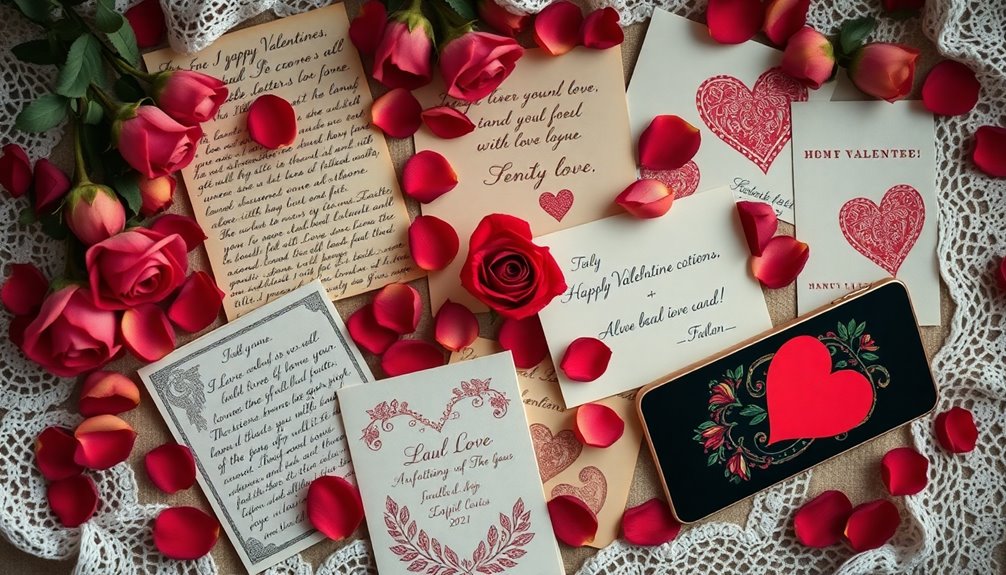
As you explore the origins of Valentine's Day, you'll discover the Roman holidays of Februa and Lupercalia, which played pivotal roles in shaping the modern celebration of love.
Februa, celebrated on February 15th, focused on purification and fertility, setting the stage for the more raucous Lupercalia. This pagan festival honored Lupercus, featuring rituals where men ran through the streets wielding goats' hide strips, believed to enhance fertility and ward off evil spirits.
Lupercalia also celebrated the myth of Romulus and Remus, the legendary founders of Rome.
Over time, these ancient customs transformed into the romantic observance we recognize today, blending with emerging Christian traditions to create a unique celebration of love and affection that continues to resonate.
Who Is St. Valentine?
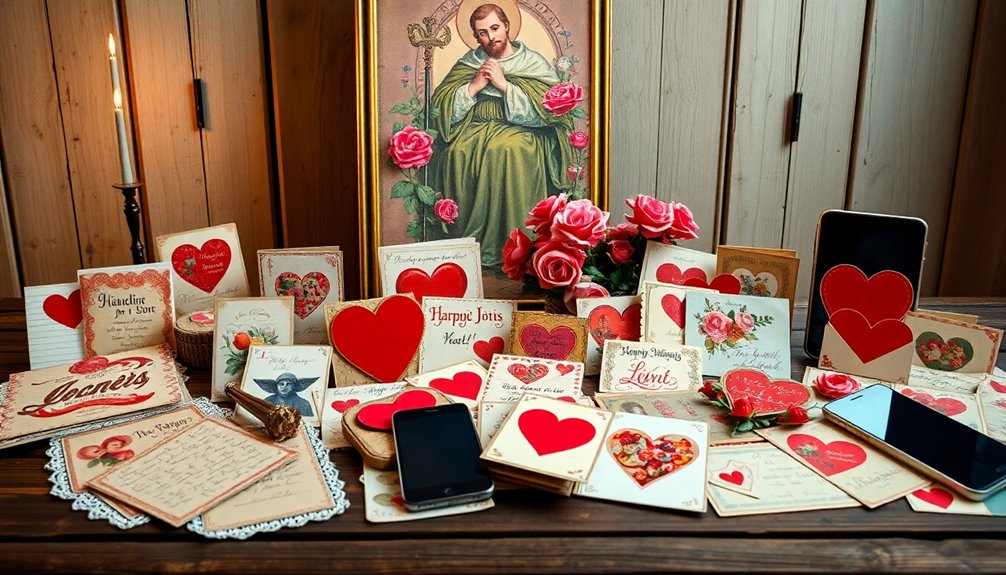
You might be surprised to learn that St. Valentine was a 3rd-century martyr who defied an emperor's order against soldier marriages.
His secret wedding ceremonies led to his imprisonment and execution, sparking legends that connect him to love.
Over time, these stories transformed him into a symbol of romantic affection celebrated on February 14th.
Historical Context of Valentine
Though many celebrate Valentine's Day with cards and flowers, the holiday's origins trace back to a 3rd-century martyr named St. Valentine. He defied Emperor Claudius II's ban on soldier marriages by secretly performing weddings, ultimately leading to his imprisonment and execution.
The history of Valentine's Day evolved over centuries, with February 14th becoming associated with love and romance long after his martyrdom. The earliest known valentine, a handwritten note from Charles, Duke of Orleans, in 1415, expressed his affection for his wife.
The romantic significance of the day gained traction in the 14th century, thanks to Geoffrey Chaucer, who linked it to the mating of birds, solidifying the origin of Valentine's Day as a celebration of love.
Legends Surrounding St. Valentine
While many know St. Valentine as the patron of lovers, his story is steeped in legend. In the 3rd century, he defied Emperor Claudius II's ban on soldier marriages by secretly performing weddings, which led to his imprisonment and execution.
The most recognized St. Valentine, from Terni, famously signed a farewell letter to Julia, the jailer's daughter, with "from your Valentine."
Initially declared a feast day by Pope Gelasius I in 496 AD for religious purposes, it wasn't until the 14th century that Geoffrey Chaucer linked it to romance.
This evolution paved the way for modern American Valentine traditions, where Valentine's Day cards and love notes celebrate affection, making St. Valentine an enduring symbol of love.
The World's Oldest Valentine's Day Card
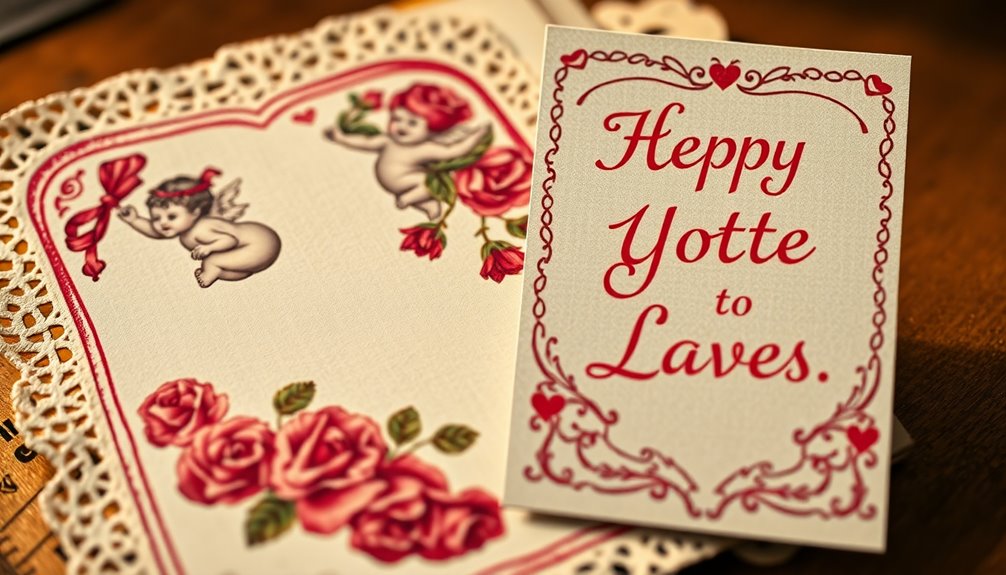
The world's oldest surviving Valentine's Day card offers a glimpse into the romantic sentiments of the past.
Written by Charles, Duke of Orleans, in 1415 while imprisoned in the Tower of London, this card was addressed to his beloved wife. It's a heartfelt poem expressing love and longing, showcasing the intimate and personal nature of handwritten notes during medieval times.
Though it never reached her, it reflects the deep emotions of that era. This early Valentine is significant as it marks the beginning of a tradition of sending Valentine's messages, which would eventually evolve over centuries.
Another notable example is from 1477, highlighting the enduring charm of these romantic gestures.
The Mass Production Era
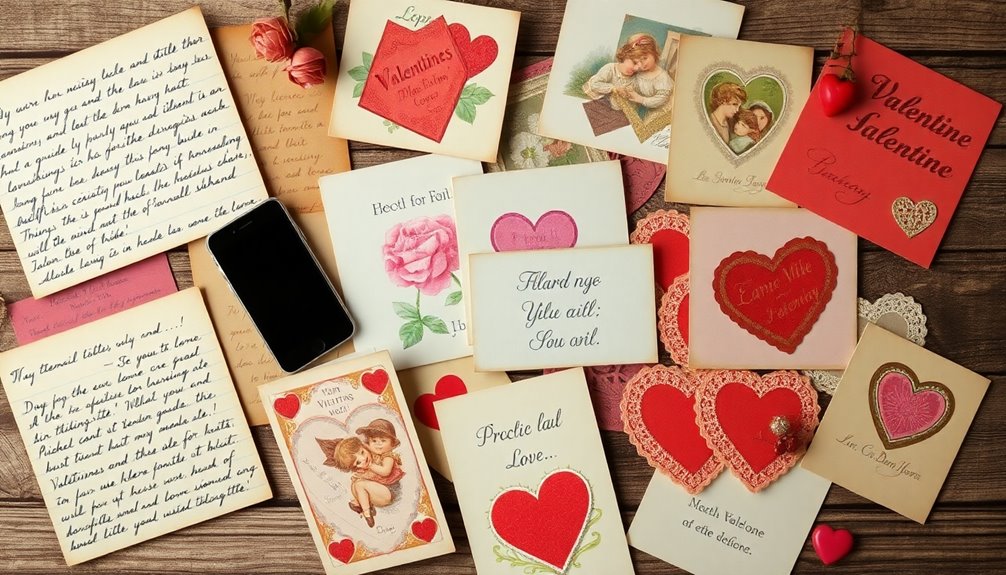
As handwritten notes of affection paved the way for romantic expression, the 19th Century ushered in a new era for Valentine's cards with the onset of the Industrial Revolution.
Mass production began in the 1840s, making printed cards accessible to everyone. With advancements in printing technology, particularly lithography, intricate designs became possible, capturing the imagination of the Victorian Era.
You could now find cards adorned with lace, ribbons, and vivid colors, appealing to a broader audience.
Esther Howland, known as the "Mother of the American Valentine," led the charge in this booming industry, producing thousands of cards annually.
The Mother of the American Valentine
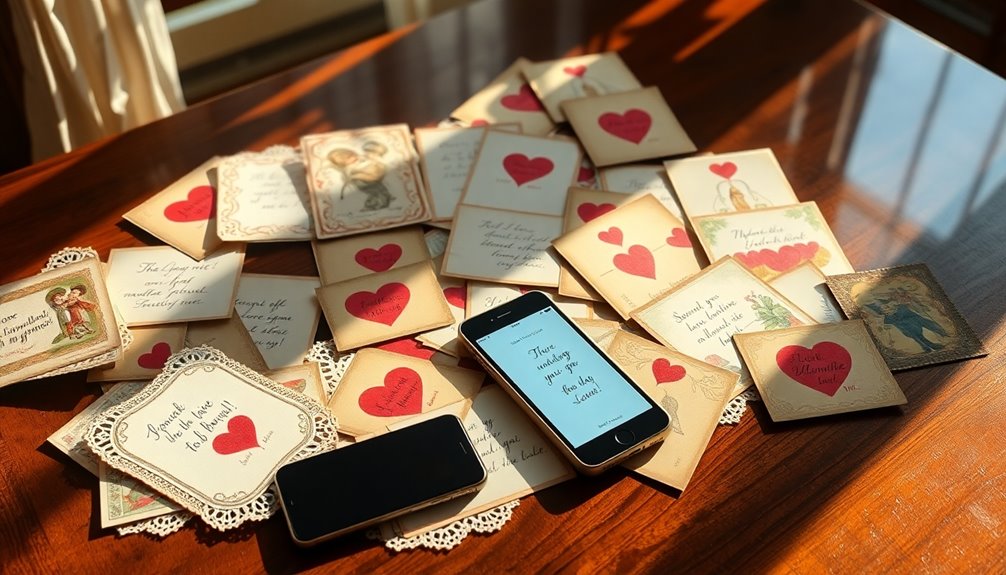
When you think about the evolution of Valentine's Day cards, Esther Howland stands out as a pioneer. Her intricate designs and innovative marketing transformed the card industry, making it a thriving business. You'll see how her creativity set the stage for the mass production of Valentine cards we enjoy today. Additionally, her approach to design echoes the rich cultural heritage found in traditional crafts, similar to the artistry seen in Indonesian decor masks.
Esther Howland's Innovations
Esther Howland, often hailed as the Mother of the American Valentine, transformed the way people express love and affection through her innovative card designs in 1849.
Inspired by elaborate English cards, she introduced printed Valentines adorned with lacey cut-outs and floral motifs. Her creativity didn't just beautify cards; it revolutionized the industry.
By establishing the New England Valentine Company, she embraced mass production, making her cards widely accessible. This shift allowed her to sell approximately $100,000 worth of cards annually by the 1870s.
Her pioneering efforts demonstrated that Valentine's Day is named not just for love but also for the commercial potential of heartfelt expressions, paving the way for future card-making endeavors across the nation. Astrology's influence on personal style can also play a role in how individuals choose to express their affection through these cards.
Impact on Card Industry
Though many may not realize it, Esther Howland's innovations have had a lasting impact on the card industry. In the 1840s, she introduced intricately designed cards that transformed Valentine's Day into a celebration of printed tokens of affection.
Her unique lacey cut-outs and illustrations set a new standard, making cards not just sentimental but also visually appealing. As demand grew, Howland's success led to the establishment of the New England Valentine Company, which shifted to a factory model in the mid-1870s, allowing cards to be mass-produced.
The Evolution of Valentine's Day Cards
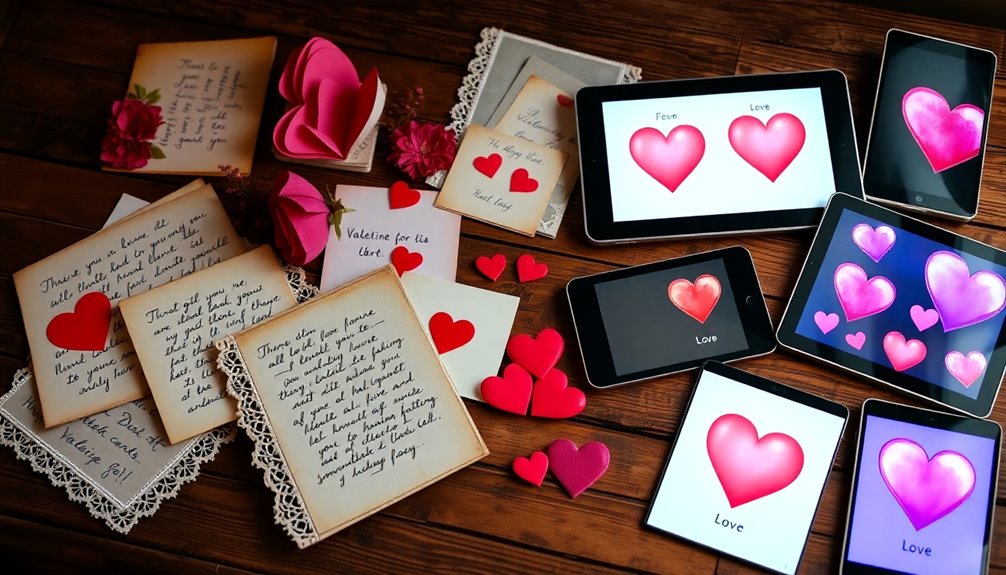
As you explore the evolution of Valentine's Day cards, you'll discover a rich history that dates back to the early 15th century. The earliest recorded card was sent by Charles, Duke of Orleans, in 1415, marking the tradition of expressing love through written notes.
With the introduction of printing in the 15th century, Valentine's cards became more accessible, gaining popularity by the 18th century. During the Victorian Era, these cards transformed into elaborate works of art, adorned with lace and floral designs.
In the 1840s, Esther Howland, known as the "Mother of the American Valentine," further fueled this trend, paving the way for companies like Hallmark in the 20th century to mass-produce cards, making them a staple of Valentine's Day celebrations.
Valentine's Day Cards Today
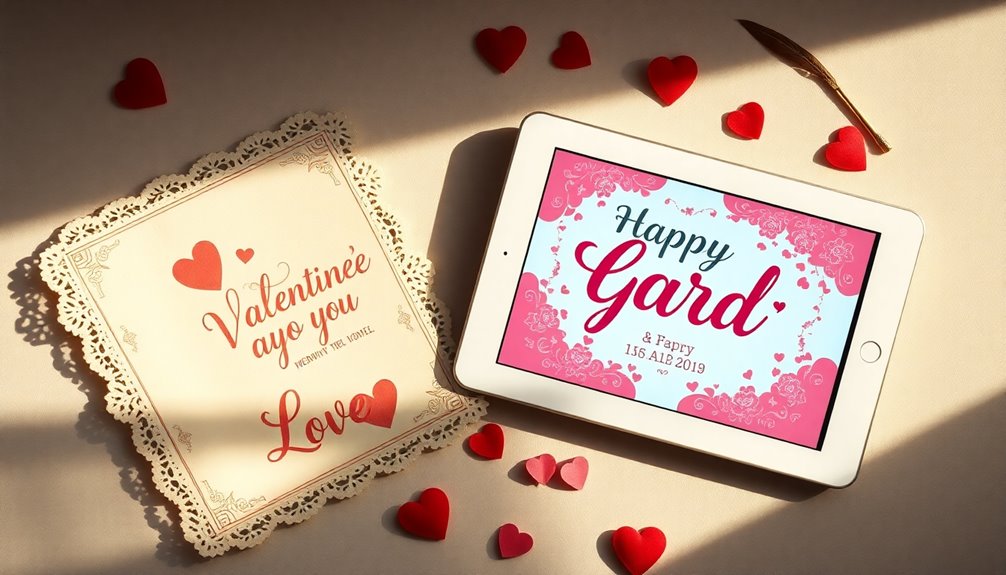
How have Valentine's Day cards transformed in our digital age? Today, you'll find a vibrant mix of cards that cater to every taste—traditional paper designs, humorous digital versions, and even handmade creations.
With about 145 million cards sold annually in the U.S., Valentine's Day ranks as the second most popular holiday for greeting cards. You can easily personalize these cards for family members or friends, adding a special touch that shows you care.
The resurgence of handmade cards reflects a desire for deeper connections and unique expressions of love. In modern times, classroom exchanges contribute to over a billion cards traded each year, blending historical traditions with contemporary creativity and fostering community among students.
Frequently Asked Questions
What Is the Oldest Known Valentine's Day Message Sent From?
You might be surprised to learn that the oldest known Valentine's Day message was sent from none other than Charles, Duke of Orleans, in 1415.
While imprisoned in the Tower of London, he penned a heartfelt note to his wife, expressing his love and longing.
Though it never reached her, this letter remains a poignant symbol of romantic devotion, showcasing the personal nature of love letters that have persisted through the ages.
What Did Esther Howland Do?
Esther Howland revolutionized Valentine's Day by creating beautiful, intricate cards in 1849.
You'd admire her lace cut-outs and floral designs, which showcased heartfelt messages.
Recognizing the charm of these cards, she founded the New England Valentine Company, making them commercially available.
Her innovative approach to card making not only set a new standard but also transformed Valentine's Day into a widely celebrated occasion, paving the way for the industry we recognize today.
When Did Valentine Cards Become Printed?
Imagine a world where love letters danced off the page. Valentine cards became printed in the 18th century, when advances in printing technology sparked a creative revolution.
Where Is the Oldest Known Valentine Greeting Card Preserved?
The oldest known Valentine greeting card is preserved in the British Library.
It's a heartfelt letter written by Charles, Duke of Orleans, in 1415 while he was imprisoned.
Even though it never reached his wife, this card showcases the personal touch that Valentine's messages have held since the beginning.
When you explore its significance, you'll see how love's expression has evolved but remains just as meaningful today.
Conclusion
As you reflect on the journey of Valentine's Day cards, from heartfelt notes to sleek digital greetings, remember that love's essence remains timeless. Each card, whether crafted by hand or sent with a click, carries a piece of the heart. Just as roses bloom in spring, your connections grow stronger with every thoughtful gesture. So, celebrate love in all its forms, and let your words be the threads that weave together the tapestry of cherished memories.
